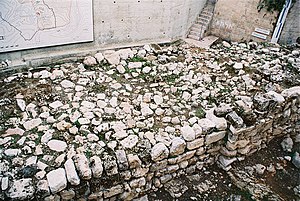
Back حصار الآشوريين للقدس Arabic Sitio de Jerusalén (701 a. C.) Spanish محاصره اورشلیم توسط آشوریان Persian Siège de Jérusalem (701 av. J.-C.) French Jeruzsálem ostroma (Kr. e. 701) Hungarian Pengepungan Yerusalem (701 SM) ID Assedio di Gerusalemme (701 a.C.) Italian Опсада на Ерусалим (701 п.н.е.) Macedonian Cerco de Jerusalém (701 a.C.) Portuguese Asirska opsada Jeruzalema Serbo-Croatian
This article needs additional citations for verification. (July 2007) |
| Siege of Jerusalem | |||||||
|---|---|---|---|---|---|---|---|
| Part of the Sennacherib's campaign in the Levant | |||||||
 Hezekiah's Wall | |||||||
| |||||||
| Belligerents | |||||||
| Neo-Assyrian Empire | Kingdom of Judah | ||||||
| Commanders and leaders | |||||||
|
Sennacherib's Rabshakeh Sennacherib's Rabsaris Sennacherib's Tartan |
King Hezekiah of Judah Eliakim ben Hilkiyahu Yoah ben Asaf Shebna | ||||||
| Strength | |||||||
| Unknown | Unknown | ||||||
| Casualties and losses | |||||||
|
Unknown
| Unknown | ||||||
| Part of a series on |
| Jerusalem |
|---|
 |
The Assyrian siege of Jerusalem (c. 701 BC) was an aborted siege of Jerusalem, then capital of the Kingdom of Judah, carried out by Sennacherib, king of the Neo-Assyrian Empire. The siege concluded Sennacharib's campaign in the Levant, in which he attacked the fortified cities and devastated the countryside of Judah in a campaign of subjugation. Sennacherib besieged Jerusalem, but did not capture it.
Sennacherib's Annals describe how the king trapped Hezekiah of Judah in Jerusalem "like a caged bird" and later returned to Assyria when he received tribute from Judah. In the Hebrew Bible, Hezekiah is described as paying 300 talents of silver and 30 talents of gold to Assyria. The biblical story then adds a miraculous ending in which Sennacherib marches on Jerusalem with his army only to have it struck down near the gates of Jerusalem by an angel, prompting his retreat to Nineveh.
According to biblical archaeological theory, Siloam tunnel and the Broad Wall in Jerusalem were built by Hezekiah in preparation for the impending siege.